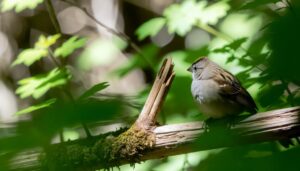How Do Black Birds Kill Sparrows?
Black birds, including ravens, crows, and blackbirds, sometimes display aggressive behaviors towards sparrows. This aggression can include chasing, pecking, and even killing sparrows, typically linked to competition for resources such as food and nesting sites.
Although instances of direct sparrow killings are documented, they are relatively rare. Studies show that this behavior helps black birds assert dominance and protect their territories.
Observational data and expert opinions suggest various ecological dynamics and interactions between these species. Those interested can further explore factors influencing these behaviors and the broader ecological implications.

Key Takeaways
- Black birds exhibit aggressive behavior towards sparrows, including chasing and pecking.
- Competition for resources can lead to physical confrontations between black birds and sparrows.
- Instances of black birds killing sparrows are documented but rare.
- Territorial defense by black birds may result in harming or displacing sparrows.
- Aggression levels increase during mating season and resource scarcity.
Black Birds Overview
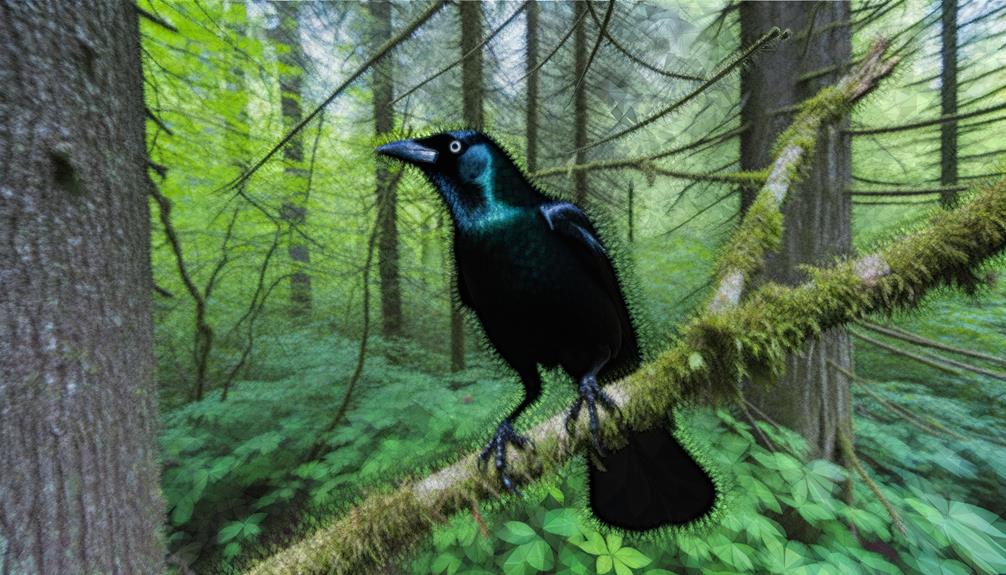
Black birds, encompassing various species such as ravens, crows, and blackbirds, exhibit diverse behaviors and habitats that are of significant interest to ornithologists.
These avian species are adaptable, often thriving in both urban and rural environments. Ravens, known for their intelligence, are frequently observed solving complex problems. Crows, with their social structures, engage in intricate communication through vocalizations and gestures. Blackbirds, particularly those in the Icteridae family, display a wide range of feeding habits, from insectivory to frugivory.
Each species' adaptability and distinct ecological roles contribute to their widespread distribution. Understanding these behaviors allows researchers to gain insights into their survival strategies and interactions within various ecosystems, including potential interspecies dynamics with birds such as sparrows.
Sparrow Characteristics
Sparrows exhibit a compact body with brown and gray plumage, often marked by distinctive streaks. They're primarily social birds, engaging in flocks and displaying consistent foraging behavior.
Sparrows prefer habitats that include urban areas, farmlands, and grasslands, where they can easily access food and nesting sites.
Physical Appearance
Typically, a sparrow exhibits a compact body structure with a conical bill, aiding in seed consumption. Its plumage often shows a mix of browns, grays, and whites, providing effective camouflage in their natural habitats.
Male sparrows usually display a black bib and striking head patterns, while females and juveniles exhibit more subdued tones, enhancing their concealment from predators. Their legs are relatively short yet robust, supporting quick, agile movements. The wings are short and rounded, enabling rapid, fluttering flight.
Sparrows possess a distinctive tail, often slightly notched, which aids in balance and maneuverability. Their eyes are large relative to their head size, optimizing their vision for spotting food and evading threats. Overall, sparrows are well-adapted to a variety of environments.
Typical Behavior Patterns
Despite their small size, these birds exhibit highly social behavior, often forming large flocks that enhance their foraging efficiency and provide protection against predators. Sparrows communicate through a series of chirps and calls that help maintain group cohesion. They display complex social structures and engage in communal activities such as preening and feeding.
Here is a concise overview of their behavior patterns:
| Behavior | Description |
|---|---|
| Flocking | Forming large groups for foraging and protection |
| Vocalization | Using chirps and calls for communication |
| Social Structure | Establishing hierarchies within the flock |
| Preening | Engaging in mutual grooming to strengthen social bonds |
| Feeding | Foraging together to increase efficiency and reduce individual risk |
This intricate social behavior underpins their survival and adaptability in various environments.
Habitat Preferences
Choosing a variety of environments, sparrows thrive in both urban settings and rural landscapes, often favoring areas with abundant vegetation and easy access to food sources. Their adaptable nature allows them to inhabit diverse locations, whether it's a bustling city park or a quiet countryside backyard.
Sparrows display a preference for:
- Dense shrubbery: Provides cover from predators and nesting opportunities.
- Open fields: Abundant in seeds and insects, essential for their diet.
- Urban gardens: Offer a mix of natural and anthropogenic food sources.
- Forests edges: Balances shelter and foraging grounds.
These habitat preferences enable sparrows to coexist with humans while maintaining their ecological roles. Observing these tiny avians reveals their resilience and adaptability across varied environments.
Natural Predators of Sparrows
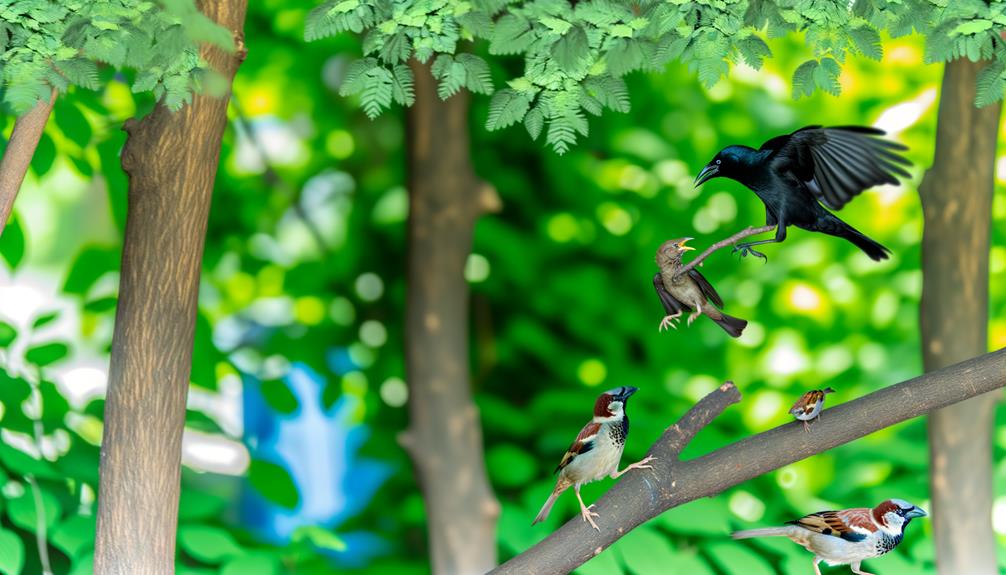
Sparrows face various natural predators, including birds of prey, mammals, and reptiles.
Particularly, larger birds such as hawks and owls frequently hunt sparrows, leveraging their keen eyesight and swift flight.
Additionally, sparrows employ several defense mechanisms, like flocking and rapid flight, to evade these threats.
Common Sparrow Predators
Various natural predators play a significant role in controlling sparrow populations, including birds of prey, mammals, and reptiles. These predators maintain the ecological balance and help sustain the health of sparrow populations by preying on the weaker individuals. The main predators of sparrows include a diverse range of species, each with unique hunting strategies and habitats.
- Cats: Domestic and feral cats are notorious for hunting sparrows, often catching them near human habitats.
- Snakes: Certain snake species prey on sparrows, especially those that nest close to the ground.
- Raptors: Birds of prey such as hawks and owls target sparrows, particularly during their nesting season.
- Small mammals: Animals like weasels and rodents occasionally hunt sparrows, especially those that forage on the ground.
This intricate web of predators highlights the complex interactions within ecosystems.
Birds Hunting Sparrows
Often, avian predators such as raptors and corvids employ specialized hunting techniques to capture sparrows, greatly impacting their population dynamics.
Raptors, including hawks and falcons, use their keen eyesight to spot sparrows from great distances. They swoop down with remarkable speed and precision, often catching the unsuspecting sparrows mid-air.
Corvids, such as crows and ravens, display remarkable intelligence in their hunting tactics. They may work in groups to flush out sparrows from dense foliage or ambush them at feeding sites.
Additionally, kestrels use their hovering ability to meticulously search for sparrows in open fields.
These predatory behaviors not only control sparrow populations but also influence their habitat preferences and foraging strategies, highlighting the intricate balance within avian ecosystems.
Sparrow Defense Mechanisms
To evade their numerous natural predators, sparrows employ a variety of defense mechanisms that enhance their chances of survival. These small birds face threats from raptors, cats, snakes, and even larger birds.
Their adaptive strategies include:
- Camouflage: Sparrows blend into their surroundings, making it harder for predators to spot them.
- Flocking: By gathering in large groups, they reduce the likelihood of any single bird being targeted.
- Alarm Calls: They emit sharp, distinct calls to warn others of approaching danger.
- Rapid Flight: Sparrows are capable of quick, agile movements, allowing them to escape predators with swift, unpredictable flight patterns.
These methods collectively help sparrows navigate the perils of their environment, ensuring their continued existence despite numerous threats.
Black Birds' Diet
Black birds mainly consume insects, seeds, and fruits, but their diet can vary greatly depending on the species and availability of resources.
For example, the common blackbird (Turdus merula) primarily feeds on earthworms and berries, whereas the European starling (Sturnus vulgaris) often targets small invertebrates and grains.
Seasonal changes also play an essential role in diet variations; during breeding seasons, there's a higher intake of protein-rich insects to support chick development.
Some black birds, like the crow (Corvus spp.), display omnivorous tendencies, scavenging for carrion and even engaging in opportunistic feeding behaviors.
This adaptability ensures they thrive in diverse habitats, from urban environments to rural landscapes, highlighting their resourcefulness and resilience in ever-changing ecosystems.
Territorial Behavior

During the breeding season, many black bird species exhibit pronounced territorial behavior to protect their nesting sites and resources. They meticulously guard their territories to secure sufficient food supply and safety for their offspring. This territoriality is driven by instinct and is critical for reproductive success.
Key features of their territorial behavior include:
- Vocalizations: Loud calls and songs to establish territory boundaries.
- Physical Displays: Wing-flapping and other gestures to deter intruders.
- Chasing Intruders: Actively pursuing any perceived threats, including other bird species.
- Marking Boundaries: Using visual markers like nests or perches to define territory limits.
Such behaviors aren't just about survival but also about asserting dominance and ensuring the continuation of their species.
Observed Aggression
Many observers have noted that the territorial behavior of black birds often escalates into aggressive actions, particularly against sparrows and other smaller birds. These aggressive displays include chasing, pecking, and, in some cases, inflicting physical harm.
Black birds, such as grackles and crows, have been seen attacking sparrows to defend their nesting sites or food resources. This aggression isn't limited to direct physical confrontations; it also includes vocal threats and intimidating postures designed to scare off intruders.
The frequency and intensity of these aggressive interactions can vary depending on the availability of resources and the density of the bird population in a given area. Such observations highlight the complex dynamics of avian territoriality and interspecies competition.
Scientific Studies
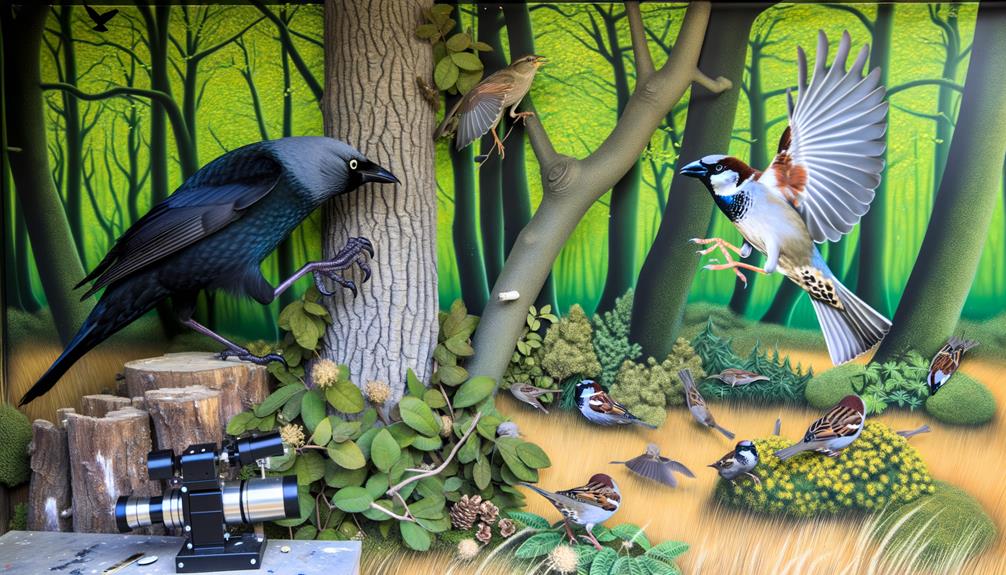
Researchers have conducted numerous studies to systematically examine the aggressive interactions between black birds and sparrows. These investigations aim to understand the reasons and outcomes of such encounters.
Key findings are summarized as follows:
- Behavioral Patterns: Studies reveal specific circumstances under which black birds exhibit aggression towards sparrows, such as competition for nesting sites.
- Ecological Impact: Research indicates that aggressive behaviors can disrupt local sparrow populations, impacting biodiversity.
- Predation Rates: Some studies have documented instances where black birds have directly killed sparrows, though such events are relatively rare.
- Species-Specific Interactions: Comparative analysis shows that not all black bird species exhibit the same level of aggression, suggesting variability in interspecies dynamics.
These scientific insights provide a deeper understanding of the complex interactions within avian ecosystems.
Birdwatcher Accounts
Anecdotal evidence from birdwatchers provides valuable insights into the aggressive interactions between black birds and sparrows, complementing scientific studies with real-world observations. Birdwatchers have frequently reported witnessing black birds, such as crows and grackles, displaying domineering behavior towards sparrows. These encounters often result in physical confrontations and displacement from feeding areas.
| Observer | Location | Observation Detail |
|---|---|---|
| A. Smith | Central Park | Crow chasing sparrows away from food sources |
| B. Jones | Golden Gate | Grackle attacking a sparrow nest |
| C. Lee | Hyde Park | Group of blackbirds driving sparrows out of a tree |
Such accounts highlight the competitive dynamics in mixed-species environments, offering essential context for understanding avian behavior.
Expert Opinions
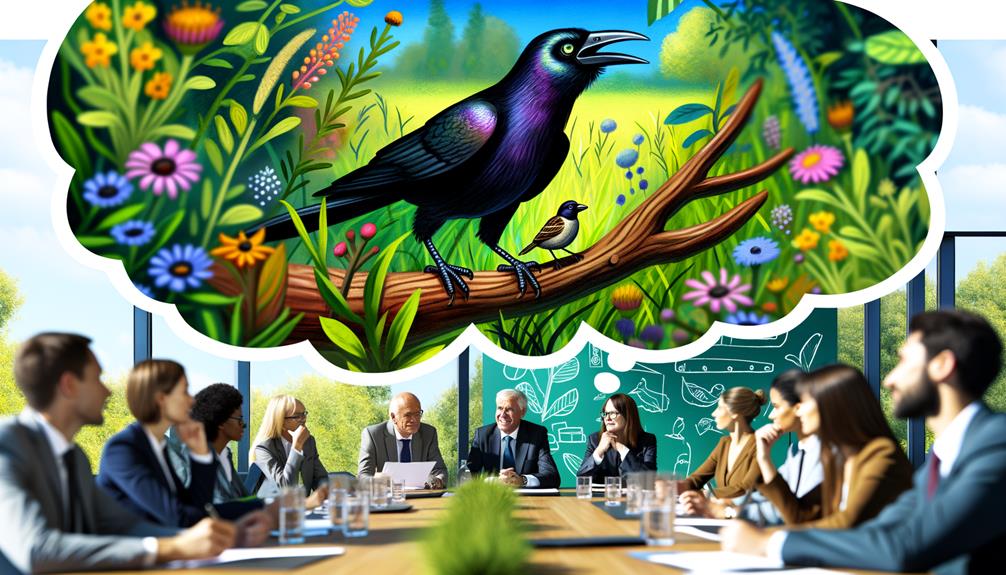
Drawing from these vivid birdwatcher accounts, ornithologists have weighed in with expert opinions to clarify the nature and implications of these aggressive behaviors. They assert that while blackbirds may exhibit territorial aggression, actual lethal encounters with sparrows are rare.
Experts highlight several factors influencing these interactions:
- Territorial Defense: Blackbirds often attack to protect their nesting areas.
- Resource Competition: Both species vie for similar food sources, heightening conflicts.
- Mating Season: Aggression spikes during breeding periods when blackbirds become highly protective.
- Species-Specific Behavior: Blackbirds' natural behavior includes chasing away smaller birds but rarely killing them.
Ornithologists emphasize understanding these dynamics to foster coexistence between species, ensuring the avian ecosystem thrives without unnecessary interventions.
Conclusion
In the intricate dance of nature, black birds and sparrows occasionally clash. Detailed observations reveal that while black birds don't typically hunt sparrows, territorial skirmishes do occur.
Scientific studies and birdwatcher accounts paint a picture of a complex avian society where aggression can flare.
Experts suggest that these interactions are more about defending territory than a predatory pursuit. Therefore, in the grand theater of the skies, black birds and sparrows engage in a nuanced interplay rather than a deadly feud.





